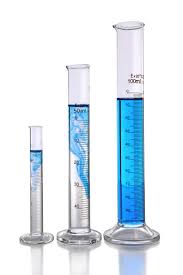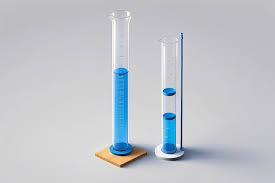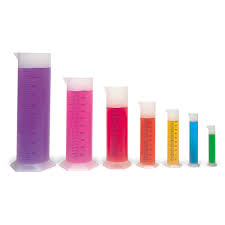Introduction:
Measuring cylinders, also known as graduated cylinders, are indispensable tools in laboratories for accurately measuring liquid volumes. Their versatility and precision make them essential for scientific, educational, and industrial purposes. In this comprehensive guide, we will explore every aspect of measuring cylinders, including their types, sizes, how to use them effectively, and much more. Whether you are a beginner or a seasoned scientist, this guide aims to provide you with detailed insights.
What Is a Measuring Cylinder?
A measuring cylinder is a cylindrical container marked with graduated lines to measure the volume of liquids. It is designed to provide accurate readings and is commonly used in various scientific disciplines. Unlike beakers, which are primarily used for mixing, measuring cylinders are specifically designed for precision in volume measurement.
Key Features of a Measuring Cylinder:
- Graduated Markings: Clear, evenly spaced lines indicating the volume in milliliters (mL) or liters (L).
- Cylindrical Shape: Allows for an even distribution of liquid and easy reading of the meniscus.
- Base: A wide base ensures stability to prevent tipping.
- Pouring Spout: Facilitates controlled pouring without spillage.

Uses of Measuring Cylinders
Measuring cylinders are employed in numerous applications across various fields. Here are some common uses:
- Scientific Experiments:
- Measuring liquids for chemical reactions or physical experiments.
- Ensuring precise volumes for reproducible results.
- Industrial Applications:
- Quantifying liquid components in manufacturing processes.
- Monitoring fluid levels in quality control tests.
- Educational Purposes:
- Demonstrating principles of volume measurement in schools and colleges.
- Training students in laboratory techniques.
- Household Uses:
- Measuring ingredients for recipes or DIY projects.
- Mixing cleaning solutions with specific liquid ratios.
How to Use a Measuring Cylinder
Using a measuring cylinder might seem straightforward, but following the correct technique ensures accuracy and avoids errors. Below is a step-by-step guide:
- Preparation:
- Ensure the cylinder is clean and free from residues or impurities.
- Place it on a flat, level surface for stability.
- Pouring the Liquid:
- Carefully pour the liquid into the cylinder, ensuring it does not splash or spill over the sides.
- Use a funnel for added precision if needed.
- Reading the Meniscus:
- Observe the liquid’s surface at eye level.
- Read the measurement at the bottom of the meniscus (the curved surface of the liquid).
- Recording the Volume:
- Note the volume indicated by the meniscus.
- For higher accuracy, use a measuring cylinder with smaller increments.
- Pouring Out the Liquid:
- Use the spout to transfer the liquid to another container.
- Pour slowly to avoid spills.
Types of Measuring Cylinders
Measuring cylinders are available in various designs, materials, and features to suit specific applications. Here are the main types:
- Glass Measuring Cylinders:
- Material: Made from borosilicate glass.
- Use: Commonly used in chemical laboratories due to chemical resistance.
- Advantages: High clarity and heat resistance.
- Plastic Measuring Cylinders:
- Material: Made from polyethylene, polypropylene, or polycarbonate.
- Use: Suitable for fieldwork or handling corrosive liquids.
- Advantages: Lightweight, shatterproof, and cost-effective.
- Graduated Measuring Cylinders:
- Description: Marked with fine graduations for precise measurements.
- Use: Ideal for experiments requiring accurate volume readings.
- Single-Scale and Double-Scale Cylinders:
- Single-Scale: Markings on one side only, easy for unidirectional viewing.
- Double-Scale: Markings on both sides, allowing visibility from multiple angles.
- Amber-Colored Measuring Cylinders:
- Feature: Tinted amber to protect light-sensitive liquids.
- Use: Ideal for measuring substances that degrade under light exposure.
- Automatic Dispensing Cylinders:
- Description: Equipped with a valve or spigot for controlled dispensing.
- Use: Perfect for repetitive measurements and dispensing.

Sizes of Measuring Cylinders
Measuring cylinders come in various sizes to accommodate different volumes. Choosing the right size depends on the volume of liquid being measured and the required precision.
- Small Measuring Cylinders:
- Capacity: 5 mL to 50 mL.
- Use: Ideal for precise measurements of small liquid volumes.
- Medium Measuring Cylinders:
- Capacity: 100 mL to 500 mL.
- Use: Suitable for general laboratory and industrial applications.
- Large Measuring Cylinders:
- Capacity: 1,000 mL to 2,000 mL.
- Use: Best for measuring bulk liquids in large-scale experiments.
- Custom Sizes:
- Some manufacturers produce cylinders with specific capacities for specialized applications.

Materials Used in Measuring Cylinders
The material of a measuring cylinder significantly impacts its durability, chemical resistance, and application. Below are common materials and their properties:
- Borosilicate Glass:
- Resistant to heat and most chemicals.
- Offers excellent clarity for accurate readings.
- Polyethylene (PE):
- Resistant to acids and alkalis.
- Lightweight and suitable for fieldwork.
- Polypropylene (PP):
- High chemical resistance and moderate heat resistance.
- Cost-effective and durable.
- Polycarbonate (PC):
- Transparent and shatterproof.
- Used for robust applications.
Maintenance and Care of Measuring Cylinders
Proper maintenance ensures the longevity of measuring cylinders and the accuracy of measurements. Follow these tips:
- Cleaning:
- Rinse thoroughly after each use to prevent residue buildup.
- Use a mild detergent and soft brush for stubborn stains.
- Avoid abrasive cleaners that may scratch plastic cylinders.
- Storage:
- Store upright in a dedicated rack to prevent tipping.
- Keep plastic cylinders away from direct sunlight to avoid material degradation.
- Inspection:
- Regularly check for cracks, scratches, or fading graduations.
- Replace damaged cylinders to maintain accuracy.
- Handling:
- Use both hands when handling large cylinders.
- Avoid sudden temperature changes, especially for glass cylinders, to prevent breakage.
Tips for Accurate Measurements
- Calibrate Before Use:
- Check the cylinder’s accuracy by comparing it with a standard reference volume.
- Avoid Parallax Errors:
- Always read the meniscus at eye level for precise measurements.
- Choose the Right Cylinder:
- Use a cylinder with graduations suited to the required precision.
- Minimize External Factors:
- Conduct measurements in a stable environment, avoiding vibrations and air currents.
Advantages of Measuring Cylinders
- Precision:
- Provides accurate liquid measurements, crucial for scientific and industrial applications.
- Versatility:
- Suitable for a wide range of liquids, including corrosive chemicals.
- Ease of Use:
- Simple design ensures accessibility for users of all skill levels.
- Durability:
- Available in materials that resist chemical corrosion and physical impact.
Fun Facts About Measuring Cylinders
- Historical Origins:
- The concept of graduated measuring tools dates back to ancient times, used in early alchemy and apothecary practices.
- Light-Sensitive Solutions:
- Amber-colored cylinders are specifically designed to handle solutions that degrade under light exposure.
- Common Laboratory Debate:
- Scientists often debate whether a pipette or a measuring cylinder provides better accuracy. The answer depends on the context!
Conclusion
Measuring cylinders are essential tools for accurately measuring liquid volumes, offering unmatched precision and versatility. By understanding their types, sizes, materials, and proper usage techniques, you can ensure reliable results in every application. Whether in a laboratory, industrial setting, or even at home, measuring cylinders play a pivotal role in simplifying and improving liquid measurements. Mastering their use and care is an invaluable skill for anyone involved in science or industry.
